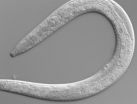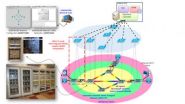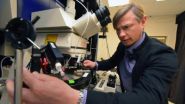(Press-News.org) PHILADELPHIA – It happens to everyone: You stay up late one night to finish an assignment, and the next day, you're exhausted. Humans aren't unique in that; all animals need sleep, and if they don't get it, they must make it up.
The biological term for that pay-the-piper behavior is "sleep homeostasis," and now, thanks to a research team at the Perelman School of Medicine, University of Pennsylvania, one of the molecular players in this process has been identified – at least in nematode round worms.
David Raizen, MD, PhD, assistant professor of Neurology, and his colleagues report in Current Biology that even in Caenorhabditis elegans, a tiny nematode worm that feeds on bacteria, loss of sleep is "stressful."
The researchers forced the animals to stay awake during a developmental stage when they normally sleep, called "lethargus." These sleep-deprived worms, like college students after an all-nighter, exhibited signs of sleep homeostasis – they were harder to wake up compared to control worms.
While nematode worms do not sleep as vertebrates do, lethargus is a sleep-like state, says Raizen, characterized by episodic reversible immobility, elevated arousal thresholds, and homeostasis.
On the molecular level, loss of sleep in the worm was associated with migration of the stress-related DNA-binding protein DAF-16, also called FOXO, from the cell cytoplasm into the nucleus. Here, the protein activates expression of stress-related genes. Knocking out that DAF-16 gene eliminated the animals' homeostatic response – the equivalent of giving an up-all-night college student a free pass on sleep deprivation.
"You might think that is a good thing," Raizen says, "but a good percentage of DAF-16 mutants died" – as many as half of the worms in some cases. That, Raizen says, suggests that the movement of DAF-16 into the nucleus is not merely a consequence of sleep deprivation, but rather a key to the homeostatic response.
"There's something important about being able to mount a homeostatic behavioral response," Raizen concludes. "We don't know what that is, but it's clearly important to the animal."
Sleep homeostasis is critical to human health. Sleep deprivation in humans has been linked to weight gain and insulin resistance, and in laboratory rats, has been linked to death, Raizen says.
Whether DAF-16/FOXO will play the same role in humans as in nematodes is an open question. But it turns out that C. elegans is actually a useful model organism for studying vertebrate neurobiology, Raizen says. Many key observations made in the invertebrate have carried over to vertebrate systems.
Interestingly, when the team asked which tissue requires DAF-16 activity in order to restore sleep homeostasis in mutant animals, they found to their surprise that it isn't neurons. But restoring DAF-16 activity in muscle tissue did restore homeostasis, suggesting an extra-neuronal component of sleep.
"The muscle must somehow communicate with the nervous system to coordinate this response," Raizen says.
INFORMATION:
Co-authors include Robert J. Driver and Annesia Lamb from the Department of Neurology, and Abraham Wyner, from the Wharton School.
The research was funded by the National Institutes of Health's National Institute of Neurological Disorders and Stroke (NS064030) and Office of Research Infrastructure (OD010440) and the Brain & Behavior Research Foundation.
Penn Medicine is one of the world's leading academic medical centers, dedicated to the related missions of medical education, biomedical research, and excellence in patient care. Penn Medicine consists of the Raymond and Ruth Perelman School of Medicine at the University of Pennsylvania (founded in 1765 as the nation's first medical school) and the University of Pennsylvania Health System, which together form a $4.3 billion enterprise.
The Perelman School of Medicine is currently ranked #2 in U.S. News & World Report's survey of research-oriented medical schools. The School is consistently among the nation's top recipients of funding from the National Institutes of Health, with $398 million awarded in the 2012 fiscal year.
The University of Pennsylvania Health System's patient care facilities include: The Hospital of the University of Pennsylvania -- recognized as one of the nation's top "Honor Roll" hospitals by U.S. News & World Report; Penn Presbyterian Medical Center; and Pennsylvania Hospital — the nation's first hospital, founded in 1751. Penn Medicine also includes additional patient care facilities and services throughout the Philadelphia region.
Penn Medicine is committed to improving lives and health through a variety of community-based programs and activities. In fiscal year 2012, Penn Medicine provided $827 million to benefit our community.
Penn researchers find molecular key to exhaustion following sleep deprivation
2013-03-07
ELSE PRESS RELEASES FROM THIS DATE:
Advance in re-engineering photosynthesis to make drugs, compounds or ingredients
2013-03-07
Scientists are reporting an advance in re-engineering photosynthesis to transform plants into bio-factories that manufacture high-value ingredients for medicines, fabrics, fuels and other products. They report on the research in the journal ACS Synthetic Biology.
Poul Erik Jensen and colleagues explain that photosynthesis does more than transform carbon dioxide and water into sugar and oxygen and generate energy.
That process also produces a wealth of natural chemical compounds, many of which have potential uses in medicines and other commercial products. However, evolution ...
Exercise shields children from stress
2013-03-07
Chevy Chase, MD ––Exercise may play a key role in helping children cope with stressful situations, according to a recent study accepted for publication in The Endocrine Society's Journal of Clinical Endocrinology & Metabolism (JCEM).
When they are exposed to everyday stressors, the study found sedentary children had surges of cortisol – a hormone linked to stress. The most active children had little or no increase in their cortisol levels in similar situations.
"The findings suggest physical activity plays a role in mental health by buffering children from the effects ...
New software could help cut hospital admissions
2013-03-07
New software, which will allow GP practice managers to improve healthcare for chronic illnesses including strokes, Alzheimer's and cancer, will be unveiled by scientists from The University of Manchester next week (13 & 14 March). Experts have devised a computer programme which analyses how many patients in a practice have suffered from different conditions over a particular time period and identifies those who might require hospital treatment in the future.
Against a back drop of a drive for NHS efficiency savings, they believe the software will help practice managers ...
Worming our way to new treatments for Alzheimer's disease
2013-03-07
Philadelphia, PA, March 7, 2013 – According to a 2012 World Health Organization report, over 35 million people worldwide currently have dementia, a number that is expected to double by 2030 (66 million) and triple by 2050 (115 million). Alzheimer's disease, the most common form of dementia, has no cure and there are currently only a handful of approved treatments that slow, but do not prevent, the progression of symptoms.
New drug development, no matter the disease, is a slow, expensive, and risky process. Thus, innovative techniques to study and assess the possibilities ...
New flex-grid system prevents optical network 'traffic jams'
2013-03-07
Services like Google Maps use algorithms to determine the fastest route from point A to point B—even factoring in real-time traffic information as you travel to redirect you if, for example, a parade is blocking part of your route. Now, a team of researchers from Spain and Japan have achieved this kind of traffic control for the connections in optical networks by using a new dynamic network management system—and it does Google Maps one better. If necessary, the flexible-grid system can also redirect the traffic-congesting parade to another street (by re-arranging one or ...
Even mild traumatic brain injuries can kill brain tissue
2013-03-07
AUGUSTA, Ga. – Scientists have watched a mild traumatic brain injury play out in the living brain, prompting swelling that reduces blood flow and connections between neurons to die.
"Even with a mild trauma, we found we still have these ischemic blood vessels and, if blood flow is not returned to normal, synapses start to die," said Dr. Sergei Kirov, neuroscientist and Director of the Human Brain Lab at the Medical College of Georgia at Georgia Regents University.
They also found that subsequent waves of depolarization – when brain cells lose their normal positive and ...
Study finds up to half of gestational diabetes patients will develop type 2 diabetes
2013-03-07
Chevy Chase, MD ––Women who were diagnosed with gestational diabetes during pregnancy face a significantly higher risk of developing Type 2 diabetes in the future, according to a recent study accepted for publication in The Endocrine Society's Journal of Clinical Endocrinology & Metabolism (JCEM).
The prospective cohort study tracked 843 women who were diagnosed with gestational diabetes between 1996 and 2003 at Cheil General Hospital in Seoul, South Korea. About 12.5 percent of the women developed Type 2 diabetes within two months of delivering their babies. During the ...
More baccalaureate-prepared nurses in hospitals connected to fewer patient deaths
2013-03-07
When hospitals hire more nurses with four-year degrees, patient deaths following common surgeries decrease, according to new research by the University of Pennsylvania School of Nursing's Center for Health Outcomes and Policy Research as reported in the March issue of the prestigious policy journal Health Affairs. Less than half the nation's nurses (45%) have baccalaureate degrees, according to the most recent data available (2008).
If all 134 Pennsylvania hospitals involved in the study had increased the percentage of their nurses with four-year degrees by 10 percentage ...
Age at first menstrual cycle, menopause tied to heart disease risk
2013-03-07
Chevy Chase, MD ––Chinese women are less likely to develop cardiovascular disease if they have their first menstrual cycle or enter menopause later than their peers, according to a recent study accepted for publication in The Endocrine Society's Journal of Clinical Endocrinology & Metabolism (JCEM).
The study also found earlier onset of menopause was associated with a higher risk of developing osteoporosis. The risk was significantly lower for women who were older than 50 when they underwent menopause. The findings could be used to identify women who are more likely to ...
Child marriages: 39,000 every day
2013-03-07
NEW YORK, 7 March 2013 – Between 2011 and 2020, more than 140 million girls will become child brides, according to United Nations Population Fund (UNFPA).
If current levels of child marriages hold, 14.2 million girls annually or 39,000 daily will marry too young.
Furthermore, of the 140 million girls who will marry before the age of 18, 50 million will be under the age of 15.
Despite the physical damage and the persistent discrimination to young girls, little progress has been made toward ending the practice of child marriage. In fact, the problem threatens to ...



